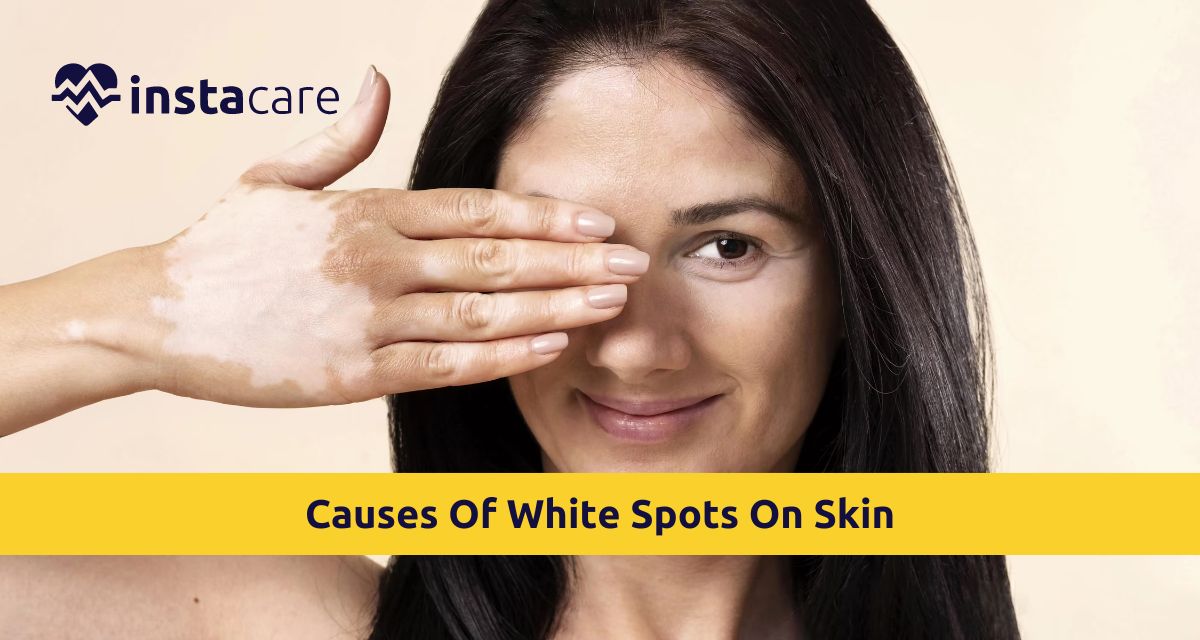White spots may develop when dead cells or skin proteins get stuck beneath the skin's surface. They may also result from depigmentation or the loss of colour brought on by vitiligo or another illness. White spots on the skin often do not create significant symptoms and are not cause for alarm. It's crucial to get them examined by a dermatologist to find out the reason for white spots and the most effective treatment for them.
Understand The Causes Of White Spots On Skin
Due to several medical illnesses and other circumstances, white spots can appear on various body parts. The following are typical causes of white patches on the skin:
As Guttate Hypomelanosis, Sunspots
White patches where skin pigment has disappeared are called
sunspots. These spots are 1-3 mm in size, usually cause no symptoms, and start
on the legs before spreading to the arms, upper back, and face.
Researchers do not know what causes sunspots. One possible cause is a deficiency in the skin pigment melanin. Moreover, sunspots appear to run in families. They are most likely to manifest after the age of forty. But they are innocuous, and the only problem with them is cosmetic. Sunspots do not necessarily indicate cancer development, even if excessive sun exposure without protection can raise the risk of skin cancer.
Pityriasis Versicolor, Or Tinea Versicolor
In individuals suffering from tinea versicolor (TV), the fungus that typically resides on the skin's surface proliferates uncontrollably. Dry, scaly, itchy areas that are either lighter or darker than the surrounding skin are caused by the fungus. These patches frequently group and expand slowly. There are situations where TV symptoms are only apparent in those with tans. The illness is widespread and warm, muggy settings tend to accentuate symptoms.
Pityriasis Alba
Pityriasis alba (PA) is a non-cancerous skin disorder that
is quite common. It causes itchy, red, scaly spots on the skin. Eventually,
these patches heal, leaving behind small white dots. PA typically affects
children between the ages of 3 and 16. It usually involves the face but can
also affect the neck, shoulders, and arms.
Although the exact etiology of PA is unknown, researchers believe it to be a mild variant of eczema or atopic dermatitis. Pigmenting pityriasis alba is an uncommon variant of PA that may go unreported. It results in bluish-white, scaly patches surrounded by an extremely pale skin patch. Similar to PA, pigmenting pityriasis alba primarily affects the face and typically appears in young people.
Vitiligo
White skin patches appear in vitiligo patients' areas where skin pigment or colour-producing cells have been damaged. Researchers are unclear about what causes vitiligo. It might be an autoimmune disease in which healthy cells are inadvertently damaged by the immune system. White patches can appear slowly or spread quickly, and they usually appear in areas exposed to the sun. Most people initially experience skin discolouration in their 20s, and vitiligo seems to run in families.
Milia
Milia are white, fluid-filled sacs that form on the skin's
surface. They are firm, elevated, painless, and 1-4 mm in diameter. Primary
milia can happen at random when keratin, a protein that aids in hardening the
skin's outer layer, becomes stuck beneath the skin and forms a fluid-filled
sac. Trauma from incidents such as dermabrasion, tissue injury, blistering, and
skin inflammation can result in secondary milia. Certain drugs may cause
secondary milia as a side effect.
An extremely unusual disorder known as milia en plaque results in raised, red, scaly, itchy patches of skin surrounding milia. There is no recognized aetiology for milia en plaque, which tends to appear sporadically in healthy skin. On the other hand, scientists believe that milia en plaque could indicate discoid lupus erythematosus. This chronic skin disease results in scarring on the ears, head, and face and inflammatory sores.
View More: How to Get Rid of Dark Circles?
Treatment For White Spots On Skin
Depending on what caused the spots, several options exist for treating white spots on the skin.
Sunspots
Apart from skin colour shifts, sunspots usually don't produce any symptoms. Thus, many people choose not to have treatment. Treatment can be necessary if the white spots are noticeable or cover a large body area. Options for treatment consist of:
- Applying sunscreen to all exposed body parts daily. Online
brand comparisons are available.
- Refraining from overexposure to the sun
- Steer clear of artificial tanning beds
- Dermabrasion: a method of physically removing the skin's
outer layers
- Online retailers offer hydrocortisone and other topical
steroid creams.
- Retinoid creams for topical use, like tretinoin and retinol
- Creams containing steroids and retinoids stimulate the skin's outer layers to peel off and cells to turnover.
Pityriasis Alba
PA symptoms can go away on their own. Many people choose not
to seek treatment despite their skin's accompanying itching or discolouration.
Several topical treatments may be recommended to treat PA-related inflammation, itching, and skin dryness.
- Options for treating PA include
- Using moisturizers regularly
- Topical corticosteroid creams are available at modest
dosages; typically, one percent hydrocortisone cream is used first. They can be
purchased online or over the counter.
- The nonsteroidal cream Elidel
Tinea Versicolor
First-line treatments are shampoos, washes, soaps, and
lotions with antifungal properties. You can purchase these online or over the
counter. Most antifungal medications contain ketoconazole, pyrithione zinc, or
selenium sulfide. After symptoms have subsided, additional antifungal
treatments may be required every month in hot surroundings or in the spring and
summer
.
Dermatologists could briefly recommend antifungal tablets when a substantial skin area is affected or does not respond to topical treatments. After the spots have disappeared, it frequently takes months for the skin to return to its natural tone.
Vitiligo
Vitiligo treatment options include topical creams, UV light
therapy, and, in extreme situations, surgery. Large areas of the skin are
typically affected by vitiligo, which also significantly discolours the skin.
Emotional anguish could result from this.
A person may utilize a combination of treatments to help
restrict or lessen the symptoms of vitiligo, depending on the severity of their
white patches and how they feel about their appearance. Some people can avoid
noticeable white patches if their symptoms are extremely mild by avoiding
letting their skin get brown.
Options for vitiligo treatment include:
- Creams containing 1% hydrocortisone, such as low-dose
corticosteroid creams
- The nonsteroidal cream Elidel
- Using topical medicines in conjunction with UV light
treatment
- Whitening the skin around noticeable white areas to make
them blend in
- Covering white areas with tattoos
- If medicine and phototherapy don't work, surgery to remove the afflicted skin's upper layers may be necessary.
Milia
Retinoids, especially creams and ointments containing 0.1 per cent tretinoin, are typically advised as the first line of treatment for milia. They can be purchased online or over the counter. Additionally, steroid creams are frequently used to help eliminate or lessen milia.
Conclusion
White patches on the skin usually don't need to be treated medically. Nonetheless, it is crucial to have a dermatologist examine white spots to rule out any underlying medical issues. Additionally, it is suggested that people discuss white spots with a doctor if they persist following a few weeks of conservative therapy, persist, reappear, expand to encompass additional body areas, or produce discomfort, itching, or emotional anguish as symptoms.

